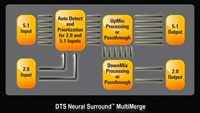DTS upmixing, loudness control ready for prime time

At the recent 2010 NAB Show, DTS demonstrated its Neural Surround MultiMerge and loudness control platforms, which enable a seamless surround-sound experience with any typical input. This DTS technology is software based and already in place via licensing to companies including Harris and DaySequerra, with additional licensees currently being negotiated.
In addition, DTS has formed a new partnership with LG Electronics, which will integrate DTS digital surround decoding into LG TVs, initially in Korea, as well as set-top DMP units in Europe and Australia.
Demonstrating the DTS-HD Master Audio suite on the show floor, product specialist Mike Matson noted that the system encompasses full loudness metering and control and up/downmixing, with the firm’s MultiMerge platform. MultiMerge parses the incoming audio signal, passing 5.1 programming untouched but performing an automated upmix on any stereo source. “When you put the MultiMerge in front of your AC-3 encoder, the encoder is always getting a full 5.1 mix without any clicks or pops as the signal transitions between stereo and surround modes. The result is a smooth, consistent surround experience for the viewer,” Matson said.
Matson emphasized that DTS treats upmixing in a fundamentally different way than other systems. “We don’t take any artistic license with content,” he said. “DTS does not use any delays or phase effects. Instead, we use a proprietary perceptual model of how the audio image would appear in a live-end/dead-end listening space. The result is a very natural-sounding, artifact-free upmix, yet with a nice, full surround element.”
Matson demonstrated the system by playing the same video sequence (from the movie “Transporter 2”) in both stereo and surround, with differing loudness levels. In unprocessed mode, their differences in perceived loudness were easily notable, as was the collapse of the audio imaging between stereo and surround processing. Then, the same sequence was run through the DTS MultiMerge software with loudness control. Loudness was stable throughout, as expected; however, the most impressive change was listening to the stereo source upmixed to 5.1 surround. The surround field was both full and appropriate, with all localization cues seeming to come from the correct speakers. Ambience is consistently in the rear, dialog centered and sound effects are keyed to the on-screen action following the location of the sources on screen, including rapid left-to-right movement and a smooth transition from rear to front as a car comes from “behind” the viewer.
DTS processing products are also fully compliant with the proposed CALM Act, which will mandate loudness control across all channels in the home video environment. DTS technology offers a choice of two forms of loudness metering. DTS offers the ITU-1770 loudness standard that will become the best practice standard under the new ATSC guidelines. In addition, the company offers a neural loudness measurement option. “It’s basically the same standard, but takes loudness control an extra step, which models how the human ear perceives loudness and adjusts those critical frequency bands,” Matson said. “The result is full loudness control that does a better job of maintaining the original program dynamics. So we’re really ahead of the curve on loudness control. Hopefully, that means the CALM Act will be good for business.”
At the NAB Show, DTS was also showing Neural Upmix, a new Pro Tools plug-in for post environments. “The Pro Tools product uses the same perceptual model that we have in our licensed products, but expands capability up for upmixes into the 7.1 realm required by Blu-ray and other formats,” said Tom McAndrew, DTS pro products manager. The plug-in handles upmixing from stereo or 5.1 sources up to 5.1 and 7.1 and is automatable for such parameters as channel trim, limiting, depth and width. “Basically, it’s a bigger toolbox of what already exists for Neural Surround for real-time playout,” McAndrew said. “The other key benefit of this product is that, if the 7.1 mix created with this product is played back in a 5.1 environment, the downmix does not create any artifacts such as those found on other existing products. That’s something we’re really proud of.” The DTS Pro Tools plug-in is currently available in RTAS and audio suite versions for both Mac and PC platforms, with a VST version coming soon.
Get the TV Tech Newsletter
The professional video industry's #1 source for news, trends and product and tech information. Sign up below.
